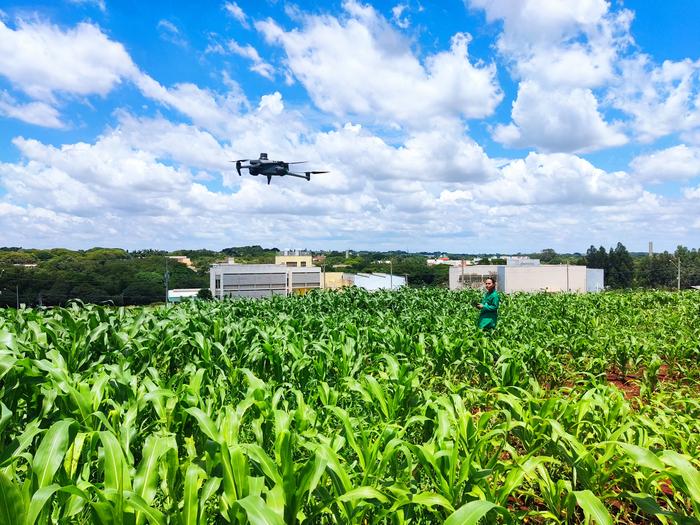A revolutionary approach to agricultural technology is taking center stage in Brazil, where researchers at the Genomics for Climate Change Research Center (GCCRC) have introduced a groundbreaking method that leverages the power of drones and low-cost imaging techniques to identify drought-tolerant corn plants. This innovative research is critical as climate change continues to wreak havoc on traditional agricultural practices, leading to increased water scarcity and heightened stress on crop yields.
Utilizing a drone equipped with a basic RGB camera and free software tools, the researchers have significantly streamlined the process of plant selection under drought conditions. Unlike conventional methods that often rely on costly multispectral imaging equipment, this new technique is not only more affordable but also allows for more efficient data collection, enhancing the study’s accessibility for smaller agricultural enterprises. With the ability to cover extensive fields in mere hours, this approach marks a noteworthy advancement in precision agriculture.
The results of this transformative research have been documented in a paper published in the Plant Phenome Journal, underscoring the scientific community’s recognition of the method’s potential to advance agricultural practices. The authors, who are affiliated with the renowned GCCRC at the State University of Campinas (UNICAMP), underscored that using a cost-effective RGB camera provided superior data collection capabilities in assessing the drought resistance of genetically modified corn varieties.
Helcio Duarte Pereira, one of the lead researchers, emphasized the practicality of this approach, explaining that the method substantially reduces the financial burden associated with experimenting on genetically modified plants. Traditionally, such experiments can be prohibitively expensive, limiting research to well-funded institutions and leaving smaller experimental setups underfunded and understudied.
During field trials conducted between April and September of 2023, the researchers gathered invaluable data on 21 varieties of corn, comprising three conventional types and 18 genetically modified variants. This experimentation occurred at a specialized testing site designed specifically for agricultural research in Campinas. The rigorous methodology allowed researchers to differentiate between plants subjected to varying water availability conditions, thus enabling a comprehensive understanding of drought tolerance.
Each drone flight lasted approximately 10 minutes and produced around 290 images, making it possible to analyze a wealth of data in a fraction of the time required by traditional methods. The research team carefully selected and compared results obtained via the low-cost RGB camera with those captured by a more advanced multispectral camera, which delivers a broader spectrum of data, including near-infrared wavelengths crucial for plant stress assessment.
Through meticulous analysis using free software, the team was able to correlate the color variations in the drone imagery with real-time, ground-based measurements of plant health. This cross-validation process not only confirmed the efficacy of the RGB camera but also enabled researchers to develop accurate predictive models for assessing drought stress in crops.
The implications of this research extend far beyond theoretical benefits. By providing a method that is both economically viable and effective, the researchers are poised to democratize access to agricultural data collection technologies. Tapping into drone capabilities has the potential to transform breeding programs and empower farmers in developing countries who may lack access to traditional high-tech solutions.
The innovative use of drones allows for ongoing regular assessments of crop performance during their growth cycles. Continuous monitoring is particularly crucial in understanding plant behavior under variable water availability scenarios, providing insights that can be adapted to upcoming growing seasons.
Moreover, the team’s development of predictive models based on their findings paves the way for future research endeavors. The indices evaluated throughout the study provide a foundation for designing applications aimed at automating water stress assessments across various crops, representing a significant leap forward in agricultural technology.
The limitations of conventional agricultural assessments—often labor-intensive and reliant on expensive tools—are being rapidly addressed through such advancements. The speed at which data can be collected and analyzed enables researchers to share findings with the broader farming community, fostering a collaborative approach to improving crop resilience in the face of climate vulnerabilities.
As the global agricultural sector grapples with the challenges posed by climate change, innovative strategies such as this undertake unprecedented importance. The ability to rapidly assess the drought resilience of crops not only benefits researchers but also feeds directly back into the ecosystem of agricultural production, boosting food security and contributing to sustainability efforts.
Undoubtedly, this pioneering method is set to inspire other research groups and startups who can explore various applications tailored to industry needs. Technologies already available in the market that assess plant chlorophyll levels and nitrogen content could further complement the advancements achieved here, leading to more comprehensive agricultural management practices and increased efficiency in resource use.
In summary, the research conducted by the GCCRC signifies a pivotal moment for the intersection of technology and agriculture. As digital tools become increasingly integrated into farming practices, we can expect to see continued advancements that enhance our ability to predict and mitigate the impacts of climate change, ensuring a resilient future for agriculture worldwide.
Subject of Research: Drought-tolerant corn plants utilizing drone technology and low-cost imaging
Article Title: Temporal field phenomics of transgenic maize events subjected to drought stress: Cross-validation scenarios and machine learning models
News Publication Date: 5-Jan-2025
Web References: Plant Phenome Journal
References: N/A
Image Credits: Paula Drummond de Castro/GCCRC
Keywords: Drought resistance, agricultural technology, precision agriculture, drone imaging, genetically modified crops, climate change, phenomics, crop resilience.




